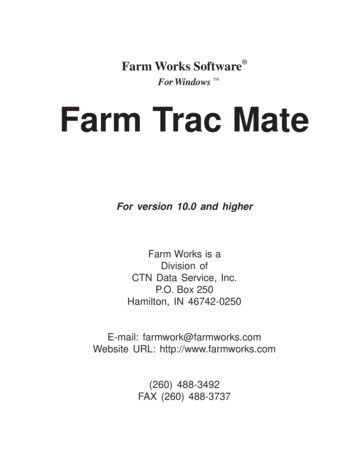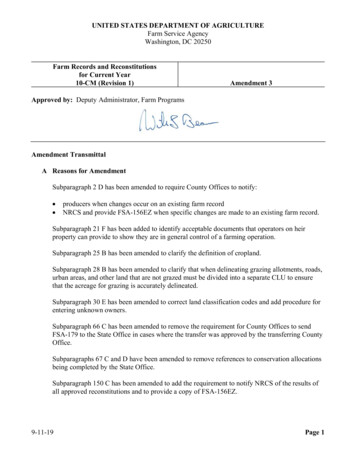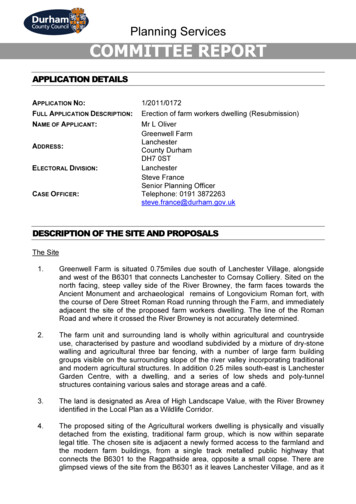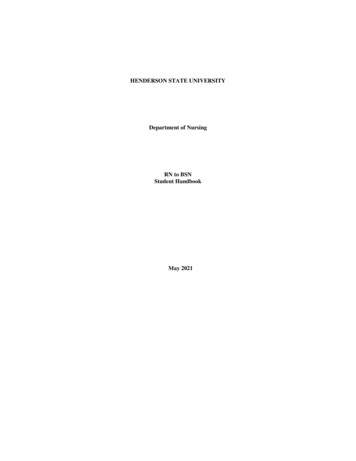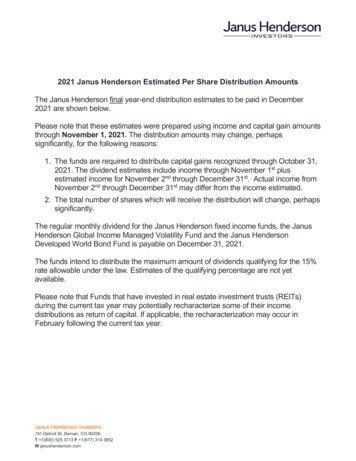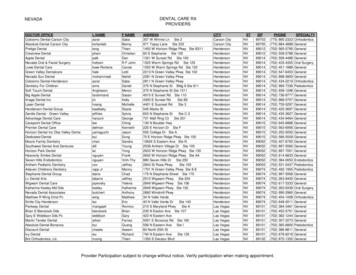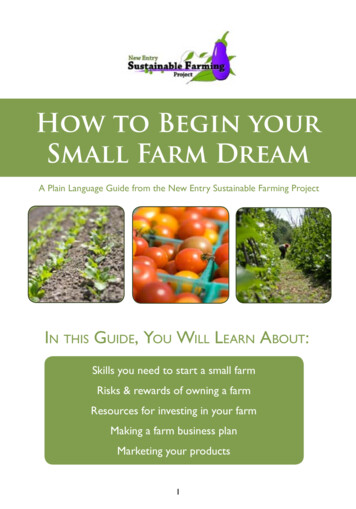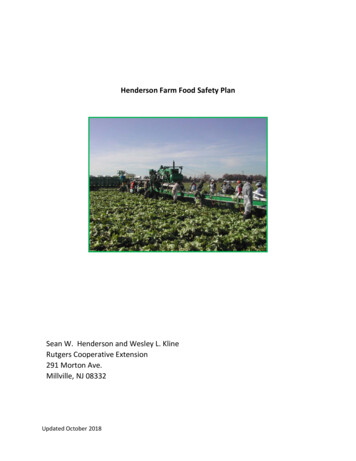
Transcription
Henderson Farm Food Safety PlanSean W. Henderson and Wesley L. KlineRutgers Cooperative Extension291 Morton Ave.Millville, NJ 08332Updated October 2018
Table of ContentsMission StatementGeneral QuestionsPart 1.) Farm ReviewPart 2.) Field Harvest and Field Packing ActivitiesPart 3.) Packing Houses FacilityPart 4.) Storage and TransportationUpdated October 2018
Mission StatementThe most important mission of the Henderson Farm is food safety. Both managementand employees are committed to producing and marketing safe product through goodagricultural and handling practices that focus on principles of food safety and quality.These safe practices include making sure there is no immediate safety risk in areaswhere produce is grown, processed and packed and there is no immediate risk ofcontamination of the product.Updated October 2018
WashStationGeneral QuestionsP‐1, P‐2G‐1The Henderson Farm has designated John Q. Farmer as the supervisor to overseeand implement our food safety program. In case John Q. Farmer (609) 555‐1212is not available, Bill H. Farmer (609) 555‐1313 will serve as the backup. The farmis located at 239 Window Road in Charles, NJ 08663. Farm phone (555) 555‐1212.All crops grown on the farm will be part of the audit and are packed in onepackinghouse. We do not pack any other grower's produce. We have a writtentraceability program, which includes field mapping and produce labeling.The Henderson Farm utilizes an efficient tracking system to track shipments fromthe farm. Each box is coded with the harvesting crew identification, specific field,harvest and packing dates and shipping address. The coded label is put on eachcontainer plus our farm name and address is on every container. The codingsystem is available for review.Updated October 2018
G‐2We review recall procedures and conduct a mock recall every six months. Duringthis mock recall, we document all communications and request the other partiesprovide verification on company letterhead of product location. A copy of thesecommunications is available for review.G‐3Potable water is always available to all employees in the packinghouseor through portable water stations located in the harvest fields. Water testresults are attached.G‐4All employees and visitors are trained and instructed on how to practiceproper hygiene. The training log is attached.G‐5In order to make sure our employees receive adequate training, we provide one‐on‐one instructions and demonstrations on proper procedures.G‐6We post signs in English and Spanish at all hand wash stations to encourage ouremployees and visitors to wash their hands. We make sure these signs arevisible to everyone. A visitor sign is posted at the main door explaining visitors'responsibilities.G‐7Employees handling produce are trained to wash their hands before beginningand when returning to work or when their hands may become dirty.G‐8Signs in English and Spanish are posted in the break area that states hands muchbe washed before beginning or returning to work.G‐9Our restrooms are cleaned and maintained on a regular basis (at least weekly)and supplied with toilet paper, single use paper towels, soap and potable waterfor handwashing. There is a receptacle for waste water and lidded trash can fordisposal of paper towels.G‐10The field sanitation units are serviced by the contracted company and we have aweekly cleaning contract from Company XYZ. Our field supervisor inspects theunits placed near the field harvest area every morning before the workers begin.A record of maintenance is kept updated in the unit.G‐11Designated smoking and eating areas are separate from production and packingareas.G‐12Workers that have diarrheal disease, along with other infectious diseases, arenot allowed to work directly with fresh produce, but may be provided with otherUpdated October 2018
jobs if appropriate. Supervisors are trained to recognize potential employeeillnesses.G‐13When blood or bodily fluid comes in contact with produce, the product isimmediately removed from the area in sealed plastic bags and destroyed. Allsurfaces that came in contact with the contaminated produce are cleaned andsanitized with a chlorine solution before using those surfaces for produce.G‐14Workers are instructed to seek prompt treatment with clean first aid supplies forcuts, abrasions and other injuries. A first aid kit is located in the packinghouseand in each field truck. Workers are required to report any injury to theirsupervisor who will determine if the employee can continue to work. Any cut orabrasion on hands are cleaned, bandaged and covered with a single use glove ofa distinct color.G‐15Persons applying pesticides and any post‐harvest materials are licensed and acopy of the license is on file.Updated October 2018
NELAC NJ11005EPA NJ01186PADEP68-05417NYDOH NY12046CTDPH PH-0143380 Scotch RoadEwing, NJ 08628609-737-3477 (p)www.njal.comNJ11005-NY12046CERTIFICATE OF ANALYSISProject Name:Harvest WaterWorkorder:N065281Meredith MelendezRutgers NJAES Cooperative Extension930 Spruce StreetTrenton, NJ 08648Project Name and Number:Harvest WaterJuly 13, 2018Dear Meredith Melendez,This report relates only to the sample(s) as received by the laboratory. Laboratory reports may not be reproduced,except in full, without the written approval of the laboratory.The issuance of the final Certificate of Analysis takes precedence over any previous Preliminary Report. Caution isadvised for the utilization of preliminary data included in reports labeled as "Preliminary Report" and should not beused for regulatory purposes. A laboratory signature is provided on final reports only.If you have any questions in reference to this laboratory report, please contact your NJAL project coordinator orlaboratory manager listed at the bottom of this report at (609) 737-3477.Note: This cover page is included as part of the Analytical Report and must be retained as a permanent record thereof.Laboratory ManagerNew Jersey Analytical LaboratoriesThe results in this report apply to the samples analyzed in accordance with the chain ofcustody document. This analytical report must be reproduced in its entirety.Robert Hulit For Susan McGrady, Quality Assurance OfficerPage 1 of 9
NELAC NJ11005EPA NJ01186PADEP68-05417NYDOH NY12046CTDPH PH-0143380 Scotch RoadEwing, NJ 08628609-737-3477 (p)www.njal.comNJ11005-NY12046CERTIFICATE OF ANALYSISProject Name:Harvest WaterWorkorder:N065281Meredith MelendezRutgers NJAES Cooperative Extension930 Spruce StreetTrenton, NJ 08648Project Name and Number:Harvest WaterJuly 13, 2018Dear Meredith Melendez,This report relates only to the sample(s) as received by the laboratory. Laboratory reports may not be reproduced,except in full, without the written approval of the laboratory.The issuance of the final Certificate of Analysis takes precedence over any previous Preliminary Report. Caution isadvised for the utilization of preliminary data included in reports labeled as "Preliminary Report" and should not beused for regulatory purposes. A laboratory signature is provided on final reports only.If you have any questions in reference to this laboratory report, please contact your NJAL project coordinator orlaboratory manager listed at the bottom of this report at (609) 737-3477.Note: This cover page is included as part of the Analytical Report and must be retained as a permanent record thereof.Laboratory ManagerNew Jersey Analytical LaboratoriesThe results in this report apply to the samples analyzed in accordance with the chain ofcustody document. This analytical report must be reproduced in its entirety.Robert Hulit For Susan McGrady, Quality Assurance OfficerPage 1 of 9
NELAC NJ11005EPA NJ01186PADEP68-05417NYDOH NY12046CTDPH PH-0143380 Scotch RoadEwing, NJ 08628609-737-3477 (p)www.njal.comNARRATIVELab Work Order # N065281Rutgers NJAES Cooperative Extension 7/9/18NJAL received the samples associated with this Chain of Custody in compliance with NJDEP guidelines .The requested analysis methods and results are detailed in the following data summary report.Sample collection was performed by the individual indicated on the chain of custody.Any exception to method procedures are listed in the comments section below,or See Data Flags, Notes & Definitions.New Jersey Analytical LaboratoriesThe results in this report apply to the samples analyzed in accordance with the chain ofcustody document. This analytical report must be reproduced in its entirety.Robert Hulit For Susan McGrady, Quality Assurance OfficerPage 2 of 9
NELAC NJ11005EPA NJ01186PADEP68-05417NYDOH NY12046CTDPH PH-0143Lab ID:N065281-01Sample ID:FP 1380 Scotch RoadEwing, NJ 08628609-737-3477 (p)www.njal.comMatrix: WastewaterDate Collected:07/09/18 08:50Date Received:07/09/18 11:03Microbiological ParametersAnalyteE. ColiResultsFlagUnitsNDUColonies/100mlNew Jersey Analytical PA 160307/09/18 15:0007/09/181The results in this report apply to the samples analyzed in accordance with the chain ofcustody document. This analytical report must be reproduced in its entirety.Robert Hulit For Susan McGrady, Quality Assurance OfficerPage 3 of 9
NELAC NJ11005EPA NJ01186PADEP68-05417NYDOH NY12046CTDPH PH-0143Lab ID:N065281-01Sample ID:FP 1380 Scotch RoadEwing, NJ 08628609-737-3477 (p)www.njal.comMatrix: WastewaterDate Collected:07/09/18 08:50Date Received:07/09/18 11:03Microbiological ParametersAnalyteE. ColiResultsFlagUnitsNDUColonies/100mlNew Jersey Analytical PA 160307/09/18 15:0007/09/181The results in this report apply to the samples analyzed in accordance with the chain ofcustody document. This analytical report must be reproduced in its entirety.Robert Hulit For Susan McGrady, Quality Assurance OfficerPage 3 of 9
NELAC NJ11005EPA NJ01186PADEP68-05417NYDOH NY12046CTDPH PH-0143Lab ID:N065281-01Sample ID:FP 1380 Scotch RoadEwing, NJ 08628609-737-3477 (p)www.njal.comMatrix: WastewaterDate Collected:07/09/18 08:50Date Received:07/09/18 11:03Microbiological ParametersAnalyteE. ColiResultsFlagUnitsNDUColonies/100mlNew Jersey Analytical PA 160307/09/18 15:0007/09/181The results in this report apply to the samples analyzed in accordance with the chain ofcustody document. This analytical report must be reproduced in its entirety.Robert Hulit For Susan McGrady, Quality Assurance OfficerPage 3 of 9
NELAC NJ11005EPA NJ01186PADEP68-05417NYDOH NY12046CTDPH PH-0143Lab ID:N065281-02Sample ID:FP 2380 Scotch RoadEwing, NJ 08628609-737-3477 (p)www.njal.comMatrix: WastewaterDate Collected:07/09/18 08:50Date Received:07/09/18 11:03Microbiological ParametersAnalyteE. ColiResultsFlagUnits1CFW1Colonies/100mlNew Jersey Analytical PA 160307/09/18 15:0007/09/181The results in this report apply to the samples analyzed in accordance with the chain ofcustody document. This analytical report must be reproduced in its entirety.Robert Hulit For Susan McGrady, Quality Assurance OfficerPage 4 of 9
NELAC NJ11005EPA NJ01186PADEP68-05417NYDOH NY12046CTDPH PH-0143380 Scotch RoadEwing, NJ 08628609-737-3477 (p)www.njal.comNotes and DefinitionsUCompound not detectedDSample required dilution due to elevated concentration above calibration range or matrix interference. Reportinglimit elevated.Confluent growth without E. ColiCFWO1CFW1Confluent growth with E. ColiDETAnalyte DETECTEDNDAnalyte NOT DETECTED at or above the Reporting Detection Limit (RDL)NRNot ReporteddrySample results reported on a dry weight basisRPDRelative Percent Difference Less than reporting limit Less than or equal to reporting limit Greater than reporting limit Greater than or equal to reporting limitMDLMethod Detection LimitRDLReporting Detection LimitMCL/ALMaxium Contaminant Level/Action Levelmg/kg wetResults reported as wet weightTTLCTotal Threshold Limit ConcentrationSTLCSoluble Threshold Limit ConcentrationTCLPToxicity Characteristic Leachate ProcedureAll work performed by New Jersey Analytical Laboratories LLC, is subject to our terms and conditions of services viewable atour office and our website: s.aspxNew Jersey Analytical LaboratoriesThe results in this report apply to the samples analyzed in accordance with the chain ofcustody document. This analytical report must be reproduced in its entirety.Robert Hulit For Susan McGrady, Quality Assurance OfficerPage 8 of 9
Page 9 of 9
Employee Food Safety Education and Training LogDate of Training:Topic:Facilitator:Materials Used and/or handouts (If applicable):Employee’s Name(Please print)JobEmployee’s Signature12345678910111213141516171819202122Sheet Reviewed by: on(Date)(Management)
Restroom & Toilet Facility Maintenance dToilet &HandWashingFacilitiesEmployee’sInitialsSheet Reviewed by: on(Management)(Date)Note: Use a different sheet for each facility
HEALTH AND SAFETY NOTICEVISITORS MUST BE AWARE OF THEFOLLOWING POINTS Toilet facilities are available for your use. Please request locations. Please follow all good hygiene/sanitation practices. Do not touch produce without washing your hands. When walking around please be aware of forklift trucks operating. Slippery surfaces are a hazard and care should be taken whilewalking around the site. Watch out for trip hazards i.e. crates, and undulations in surfaces andedges of concrete surfaces. Head injuries: watch out for low pieces of tunnel/glass structures. After the visit make sure hands are thoroughly washed before eatingmeals.Sheet Reviewed by: on(Date)(Management)
Mock Traceback LogName of Operation:Date:Conducted By:Lot:Product(s) traced:Please see the food safety plan for overall traceback procedures.Step BackwardFieldNo.Harvest DatePackingDateShipping DateStep ForwardAmount ofProduct/LotCodeCustomer(s)ContactedProduct remainingat customer/LotCodesDisposition ofproduct which couldnot be recalledSheet Reviewed by: Title: Date:November 2018
Part 1: Farm Review1.1The Henderson Farm uses pond water as the main irrigation source. In the springwe inspect the entire water system making necessary repairs and documentingactions taken.1.2We irrigate our crops with sprinkler systems.1.3, 1.4Water testing is completed three times every growing season (when the pump isfirst turned on, at mid‐season, and two weeks before harvest) to ensure that thewater used is safe for irrigation, spraying and fertigation use. Water test resultsare available for review.1.5In the event of contamination from runoff from a pasture or wash water occurs aberm is built along the edges of the field.1.6, 1.7The septic system is not located near a production area and is inspected yearlyfor possible issues.1.8, 1.9Our crops are not located near any dairy, livestock or fowl production facilities.This eliminates the threat of potential contamination from manure and othercontamination sources.1.10In addition, we do not store or apply manure, municipal biosolids or any otherbiological soil amendments on our farm.1.11We make sure our water is safe from potential outside contamination by fencingthe pond to exclude animals.1.12We monitor for animals throughout the growing season and increase ourmonitoring two weeks prior to harvest. If evidence is found, a decision is madeconcerning our harvest procedures. Monitoring logs are available for review.1.13We have put up electric wire around our field to keep our pets and otheranimals, including deer, from entering the field. We allow hunting during theseason and obtain a predation permit off‐season.Updated October 2018
Note: In the audit there are three options related to manure. Select the examplethat applies to your operation.Manure and Municipal BiosolidsOption A: Raw Manure1.14Our first choice is to apply manure to field crops in rotation. Records aremaintained for application and planting dates for crops by field. Logs are kept.1‐15Raw manure is only applied to crops that will not be harvested for at least 120days after planting. Manure application dates are recorded by field and logs areavailable for review.1‐16Should we decide to compost our manure, the temperature is monitored toensure it reaches 131 F for at least three days and the pile is allowed to age priorto application. The temperature is recorded and logs are available for review.1‐17Steps are taken to keep the treated/composted manure from coming in contactwith any raw manure. We do this by using separate areas, tools andtransportation vehicles for each and building berms to prevent contaminationfrom potential runoff from the raw manure.Option B: Composted Manure1‐18Only composted manure is applied for soil amendments. Records of applicationtimes and compost records are available for review.1‐19The compost temperature is monitored to ensure it reaches 131 F for at leastthree days and the pile is allowed to age prior to application. The temperature isrecorded and logs are available for review.1‐20Steps are taken to keep the treated/composted manure from coming in contactwith any raw manure. We do this by using separate areas, tools andtransportation vehicles for each and building berms to prevent contaminationfrom potential runoff from the raw manure.1‐21If purchasing compost, analysis reports are requested from supplier and are kepton file.Updated October 2018
Option C: No Manure/Biosolids Used1‐22We do not use any manure or biosolids on the farm.1‐23All previous history of our land shows that there was never any imminent risk ofcontamination.1‐24The land initially was an open meadow and over the past 10 years has been usedfor corn, carrot and soybean production. If there had been potentialcontamination, a microbiological and heavy metal soil test would have beenperformed.1‐25Occasionally we have flooding in some of the lower fields, but we are proactivein testing for potential contamination of our produce by conducting amicrobiological and heavy metal soil test. If contamination was present, wewould destroy that portion of our crop.1‐26Each of our fields is numbered to ensure traceability of our products. In theevent of a recall for our produce, we know exactly what, when and where ourproduce originated. See attached map for details.Updated October 2018
PAGE 1 OF 1COMPOST 'TOTALS' ANALYSIS REPORTSample 1GUIDEWindrow 130TypicalCrop:n/gCompostClient:Qld OrganicsNutrientsUnitsC9095/1(average)Block 630.8SulphurS%0.85 0.5CarbonC%35.6 9 /kg1,1961,200Nitrogen : Sulphur Ratiounits5.0 4Nitrogen : Phosphorus Ratiounits1.64Nitrogen : Potassium Ratiounits1.62Carbon : Nitrogen Ratiounits8.4 15Organic Matter%26.5 50pH (1:5 water)na7.25.0 - 7.5Electrical Conductivity (1:5 water)dS/m13.7No limitMoisturesee note 6%28.4 25Cl%0.8No limitAluminiumAlmg/kg733 5000SeleniumSemg/kg1.62CadmiumCdmg/kg 0.5 10LeadPbmg/kg 1 100ArsenicAsmg/kg3 50ChromiumCrmg/kg6 100NickelNImg/kg9 50MercuryHgmg/kg 0.1 5SilverAgmg/kg 1 5Ecolicfu/gNil.Salmonellacfu/gNil detected.Listeriacfu/gNil detected.Total Aerobic Countcfu/g21,500,000.see note 7PathogensHeavy MetalsChlorideNotes:1. All analysis is dry weight - Samples dried at 40 C for 24hours prior to fine grinding2. Samples digested on a hotblock digestor using Aqua Regia acid and read on the ICP-MS3. Carbon/ Nitrogen/ Sulfur measured using a LECO CNS2000 Analyser4. mg/Kg ppm; 1% 10,000ppm5. By Calculation:- Crude Protein %N x 6.256. Moisture based on sample dried at 105 C7. Nitrate/Ammonium/Chloride measured on a water extract.8. Organic Matter is %C x 1.75Environmental Analysis Laboratory, Southern Cross University,Tel. 02 6620 3678, website: scu.edu.au/ealchecked:.
Animal Monitoring orrective Action NeededSheet Reviewed by: on(Management)(Date)
Part 2: Field Harvest and Field Packing Activities2‐1An assessment is made the day before starting to harvest to ensure everything isin place to reduce the chance for product contamination (see log). If a field isharvested over several days, each morning the assessment is repeated.2‐2,2‐3Our farm makes sure all employees in the field take the necessary precautions toavoid contamination of the produce. the number, condition and placement offield sanitation units comply with OSHA and WPS safety requirements. The unitsare located within a ¼ mile walk or 5‐minute drive.2‐4These field sanitation units are always located in a safe area, out of the fieldbeing harvested, that poses no potential risk for contamination and are directlyaccessible for servicing.2‐5If there is a spill or leak, a soil berm is constructed around the unit and theservice company is immediately contacted. A1 Portable Toilet Company, (609)555‐1212.2‐6All products are harvested by hand. All equipment and harvesting containers arekept clean and are sanitized before use in the spring. During the productionseason, containers are checked and cleaned/sanitized as needed.2‐7Hand‐harvesting knives are kept clean and sanitized daily with a chlorinesolution. Hand‐harvesting knives are cleaned as necessary during use, and arecollected at the end of the day, cleaned/sanitized and stored in a designatedarea in the main barn.2‐8If harvest containers are broken, they are discarded. Damaged pallets arerepaired prior to use.2‐9We inspect all equipment and harvesting machinery prior to use and makerepairs as needed.2‐10All light bulbs and glass on the harvesting equipment are protected to ensurethat contamination of the fields does not occur.2‐11If glass does break, the contaminated area will not be harvested and anyproduce that had been harvested from that area will be placed in plastic bagsand removed from the field. A five‐foot buffer to not harvest will be establishedaround the area.Updated October 2018
2‐122‐13If products such as chemicals, petroleum, pesticides, or foreign objectscontaminate our produce, the affected area is flagged, and a five‐foot buffer isnot harvested.All produce is harvested by hand.2‐14Harvest baskets and totes are used only for picking and are stored in adesignated area in our main barn. Containers used for activities besidesharvesting are labeled not for harvest.2‐15No water is applied to harvested product in the field.2‐16Harvest containers and product have excess dirt removed from them. Pickingcontainers are not set on the ground. A separate marked container is placedbeneath the harvest baskets to prevent the harvest container from coming intocontact with the soil.2‐17The wagons and trailers used at the Henderson Farm are kept clean from dirtand debris before the loading process. They are cleaned off after each load.2‐18Once picked, our products moved from the field are always covered by tarps. Inaddition, we unload our trailers under a roof overhang.2‐19When we pack produce in the field, we are sure to use only new or sanitizedcontainers.2‐20We keep these containers on the truck, on clean pallets and covered with tarpsto prevent contamination from soil, bird droppings or other animal fecal matter.2‐21For the harvest of each field, we print out a “trip ticket” listing the date, fieldnumber and number of units packed, and this is kept with the harvestedproduce. This way we can clearly identify any produce in question in the event ofa recall.Updated October 2018
Knife Cleaning LogDateNumber CleanedDisinfectedCommentsInitialsSheet Reviewed by: on(Management Signature)(Date)
Pre-Harvest Assessment LogQuestionsAre Toilet and wash facilitiesproperly located?Is potable water available forworkers?Are harvest containers available,clean, well located and protected?Is harvest equipment available andin good condition?Are disinfection containers forknives available?Is there evidence of unauthorizedentry in the crop area and if so, hasit been investigated?Is there evidence of domestic orwild animal crop damage?Is there evidence of physicalcontamination in the crop area?Are fuel and chemicals whichmight contaminate crop areasisolated?If areas are contaminated are theyisolated for “no-harvest”?Are there any other notable sourcesof biological or physicalcontamination such as dump sites,manure, burning debris, water thatmay affect food safety?Is transportation equipment cleanand available?YESNON/ACorrective ActionInitialsSheet Reviewed by: on(Management Signature)(Date)
Field Harvesting Equipment and Transportation edSanitizer UsedAgent/RateEmployee’sInitialsSheet Reviewed by: on(Management)Sample record keeping sheet. Modify to fit your operation.(Date)
Harvesting Container Sanitization PalletsSanitizerUsedAgent/RateSanitizedNumber �sInitialsSheet Reviewed by: onManagement SignatureDate
Part 3: House Packing Facility3‐1The Henderson Farm would like to emphasize that we transport the productcovered and in a safe manner.3‐2Once the product arrives, it is properly stored in the packinghouse. If the productwill be packed several hours or days later, we make sure the product is stored ina refrigerated cooler for the produce that requires refrigeration. Our food safetysupervisor regularly monitors and logs the temperature and makes sure that thecondensation pipes are functioning properly so that the condensate is goingoutdoors and not contaminating the produce. For the produce that does notrequire refrigeration, the produce is kept under a covered area and protectedfrom pests.3‐3On the washing and packing lines, well water used for all processes is potableand tested annually as demonstrated by water tests which are available forreview.3‐4The temperature of this water is monitored in the dump tank hourly and we usethe temperature recommended for each type of produce. Logs are available forreview.3‐5Processing water is treated to reduce risk of contamination.3‐6We clean and sanitize all food contact surfaces prior to grading and packing. Atthe end of the day, all packing areas are thoroughly cleaned and sanitized. Thisincludes washing, grading, sorting and packing lines and logs are available forreview.3‐7Chlorine is used to treat water as per label instructions and the pH andconcentration is checked hourly. Logs are available for review.3‐8We clean and sanitize all water contact surfaces prior to grading and packing. Atthe end of the day, all packing areas are thoroughly cleaned and sanitized. Thisincludes washing, grading, sorting and packing lines and logs are available forreview.3‐9To ensure worker and food safety, all our motors are equipped with shields andonly food‐grade lubricants are used. All facility fixtures, including, but not limitedto, pipes, lights, ceiling and storage areas, are regularly inspected andmaintained to keep our product flow zone free of potentially harmfulcontamination. Logs are available for review.Updated October 2018
3‐10Ice is used during packing, but we do not manufacture it. A copy of themanufacturing and storage procedures used for ice and their water reportresults are obtained annually from the manufacturer and are on file.3‐11All ice is transported to the packinghouse in a closed truck in plastic bins.3‐12As mentioned in previous sections, our employees are trained and educated onworker hygiene. This includes break areas away from packing areas, followed byproper handwashing.3‐13We have a written policy that all employees and visitors must wear headcoverings (hairnets, ball caps or beard nets) while working on the packing line.3‐14Jewelry is not allowed except for watches and plain wedding rings. Employeeswho do not comply will not be allowed to work on the packing line.3‐15Only food grade lubricants are used on the packing equipment.3‐16If there are chemicals not approved for use, they are stored away from the area.3‐17, 3‐18We also make sure that all areas of the packinghouse remain clean and free fromlitter, debris and standing water.3‐19Our dumpster areas are not located near the packinghouse. In addition, anygarbage cans inside the packinghouse have lids.3‐20Our packing facility is a completely enclosed structure, complete with screensand locking doors.3‐21When we have finished working for the day, the workers clean up themachinery, any debris on the floor, and return any tools/materials to theirproper storage place. We close up and lock the facility every night.3‐22Floor drains in the packinghouses are open, covered with grates and checkedweekly to ensure proper drainage.3‐23All pipes, fans and ceilings in the packinghouse are cleaned every six months.Logs are available for review.3‐24Glass lights in the packinghouse are covered in case of breakage withshatterproof covers.Updated October 2018
3‐25The Henderson Farm takes measures to ensure that if wastewater spillageoccurs, it is far enough away from the product so no contamination will occur. Ifcontamination does take place in the packinghouse, we use potable water andhydrogen dioxide to decontaminate the area.3‐26Any product, packed or unpacked, including fully packed boxes, that comes incontact with the floor is immediately discarded in th
and implement our food safety program. In case John Q. Farmer (609) 555‐1212 is not available, Bill H. Farmer (609) 555‐1313 will serve as the backup. The farm is located at 239 Window Road in Charles, NJ 08663. Farm phone (555) 555‐ 1212.
